Samples of stone tools from the site are routinely screened with optical light microscopy. Previously, individual twisted plant fibres, some of which were multicellular, were reported on stone tools from Abri du Maras6. The authors suggested that these might be remnants of cordage, but the remains were too fragmentary to be conclusive. During further screening with reflected light microscopy, we discovered a fragment of string on a Levallois flake (sample G8 128) from Level 4.2 (Fig. 2). The flake was recovered in situ with the cord adhering to its inferior surface and was covered by sediment and breccia, demonstrating that the cord is at least contemporary with the deposition and burial of the flake and is therefore Middle Paleolithic in origin. The specimen was also imaged using an environmental SEM imaging platform of the National Museum of Natural History (MNHN, Paris) and a Hirox 2D/3D digital microscope at the Centre for Research and Restoration of the Museums of France (C2RMF, Paris). Examination of photomicrographs revealed 3 bundles of fibres with S-twist which were then plied together with a Z-twist to form a 3-ply cord14. The cord is approximately 6.2 mm in length and approximately 0.5 mm in width (Figs. 3, 4). The morphology of the cord fragment closely resembles replica cords produced in modern materials (see SI Fig. 1). Based on the presence of bordered pits15 with torus-margo membranes which are arranged in parallel lines, the fibres resemble gymnosperm (conifer) and come from the inner bark16,17. The torus is surrounded by a margo that controls the pressure in the conifer water transport system,; this mechanism is a strategy that distinguishes gymnosperm from angiosperm (flowering plants)18,19. Juniper, spruce, cedar, and pine bast have been used archaeologically and historically in the manufacture of cordage and textiles (see Supplemental Information). The presence of pine at the Abri du Maras is confirmed through palynological20 and charcoal analysis12. We also collected modern fibre samples from 18 materials that were present during the excavations and examined them microscopically. None of these matched the fibres from sample G8 128.
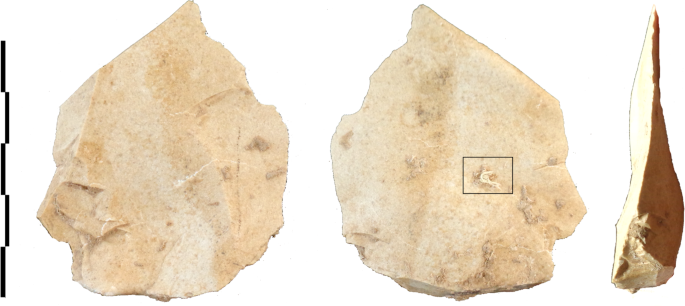
Levallois flake (G8 128 Level 4.2) with adhering cord fragment. (Photo by M.-H. Moncel).
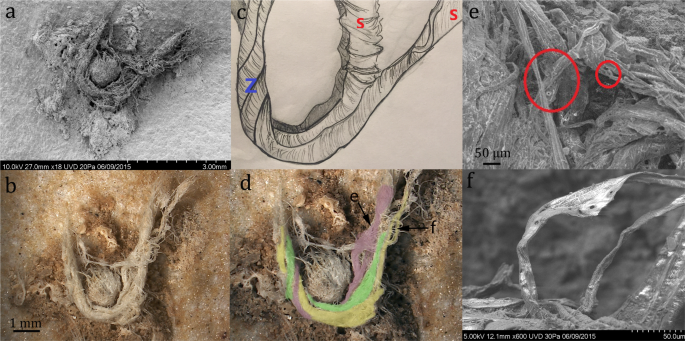
(a) SEM photo of cord fragment, (b) 3D Hirox photo of cord fragment, (c) schematic drawing illustrating s and Z twist; (d) enlarged Hirox photo with cord structure highlighted, arrows indicate location of photos e and f; (e) SEM photo of bordered pits (circled in red); (f) SEM photo of bordered pits. (Drawing by C. Kerfant; Hirox: C2RMF, N. Mélard).

SEM photo of 3-ply cord. First closeup shows Z-twist of strands (image rotated 90° counter-clockwise for clarity); 2nd closeup shows S-twist of fibres within a single strand.
In addition to the cord fragment described here and examples of twisted fibres illustrated in previously published photos6, a number of artefacts have plant/wood fibres adhering to their surfaces but do not exhibit sufficient twisting or plying to confidently identify them as remains of cordage. In some cases these show some twists while in other cases they do not. It is possible that these fibres are related to cordage or cordage manufacture, but, thus far, the sample on flake G8 128 is the only one to exhibit clear structure of a multiple ply cord. Figures 5–7 show fibres on artefacts L6 791 (Level 4.2) and I6 333 (Level 4.1). Both artefacts were found in situ and were handled in the same manner as artefact G8 128 and the cordage fragment (unwashed, placed in zip style plastic bags until microscopic analysis).
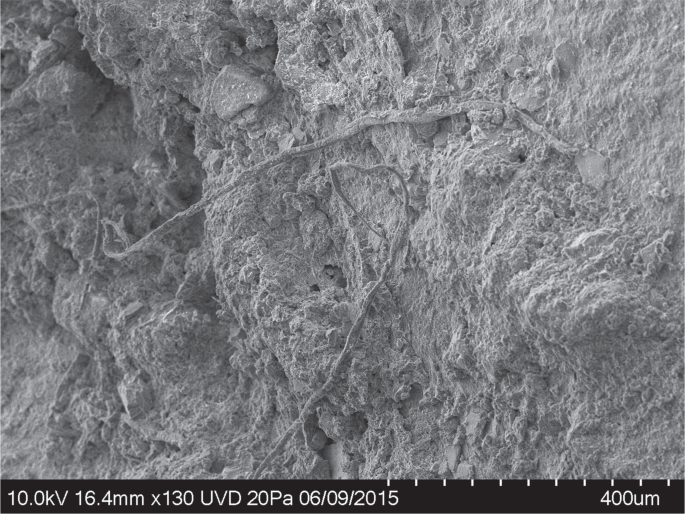
SEM photo of untwisted fibres on artefact L6 791.
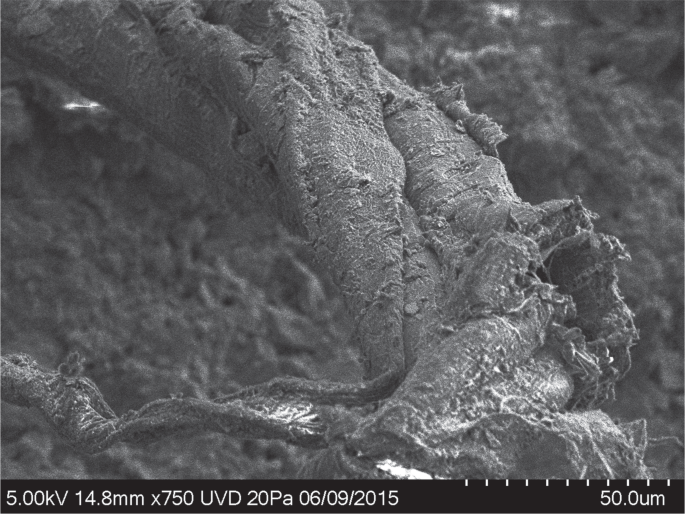
SEM photo of multiple fibres showing a Z twist on artefact L6 791.
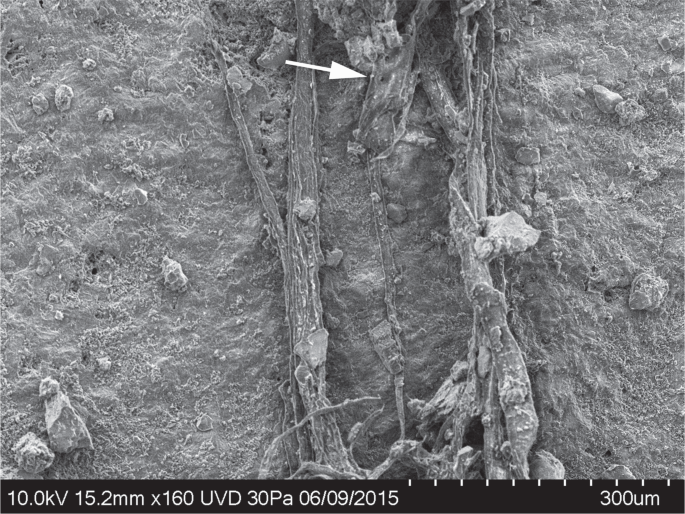
SEM photo of multiple untwisted fibres on artefact I6 333. Arrow indicates bordered pits suggesting a conifer origin for the fibres as with the cord fragment on G8 128.
We applied FT-Raman spectroscopy to the cord on sample G8 128 to determine the composition of the preserved fibres (Fig. 8). Raman spectrometry was the most suitable technique considering is high spatial resolution and its non-invasive application. This technique is becoming increasingly common in analysis of residues on stone tools21,22 and is used here to corroborate visual identification of plant residues.
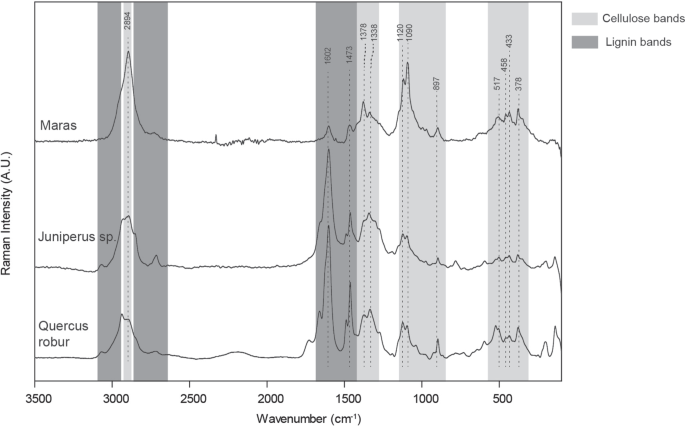
Representative spectrum obtained by FT-Raman spectroscopy on Maras fibres on artefact G8 128 compared to those acquired on modern juniper and modern oak.
Raman spectra analysis exhibits several bands characteristic of cellulose (1378, 1338, 1120, 1090, 897, 519 cm−1). The weaker presence of lignin is also attested to by the band at 1602 cm−1 23,24. Several micro-analyses were performed at different locations on the cord sample and yielded the same spectral signature illustrated in Fig. 5. Analyses focused outside the cord sample did not exhibit an organic substance signature. These results confirm that the molecular nature of these residues is consistent with an interpretation of wood components. Spectra from modern Quercus and Juniperus are included as examples of hardwood and softwood respectively. Note that the peaks match, but that obviously the Maras sample has been degradated. The proportions of lignin and cellulose vary according to wood species and in particular between hardwood (angiosperms) and softwood (gymnosperms, including conifers). Holocellulose (cellulose and hemicellulose) is the main component of woods with the proportions varying between 65–80% for softwood and between 70–90% for hardwood, the remainder consisting mainly of lignin. Cellulose is typically more sensitive to degradation than lignin, with generally low cellulose content in archaeological samples25.
However, burial in an alkaline environment like carbonaceous bedrock can induce a preferential degradation of lignin and hemicellulose26. Aging could have thus modified the relative proportions of lignin and cellulose in the analyzed fibres and it is not possible to reconstruct the initial composition because of their alteration. These results highlight the exceptional preservation of this organic material with the conservation of the cellulose molecular structure. The localization of this material, in contact with a carbonaceous breccia, could have favored the deposits of calcite minerals protecting the fibres from further alterations. Previous work has also demonstrated that the flint at Abri du Maras is covered with a microscopic post-depositional film of chalcedony, which may also aid in preservation27.
The cord is not necessarily related to the use of the tool. Its presence on the inferior surface of the flake during excavation demonstrates that it was deposited before or contemporaneous with the flake. If it was contemporaneous with the deposition of the flake, it could have been wrapped around it as part of a haft or could even have been part of a net or bag. Previous analysis of impact fractures on artefacts from the site suggests the use of hafting and provide potential support for this possibility6. If it was deposited before the flake, it could represent a number of different items but nonetheless illustrates the use of fibre technology at the site.
At present, the earliest possible evidence of fibre technology are the shell beads from Cueva Anton with a minimum age of 115 ka28. Shell beads may have been strung or tied to clothing as personal ornamentation, although this could have been accomplished with sinew or a leather thong as well as cordage. Conard and Malina29 have recently posited that perforated ivory artefacts (lochstäbe) from Aurignacian sites in the Swabian Jura were used for spinning plant fibres for rope-making or textiles. Other early indirect evidence of fibre technology is impressions on fired clay from Gravettian sites in Moravia as early as 28 ka3. These impressions reveal weaving technology and the production of textiles. The complexity of the textiles suggests that they are part of a well-established tradition that began much earlier.
In terms of the actual preservation of fibre technology, the Upper Paleolithic waterlogged site of Ohalo II yielded three fragments of fibres with a Z twist approximately 19 ka30. Remnants of a 6-ply cord were found at Lascaux and date to approximately 17 ka31. The cord fragment from Abri du Maras is older still, dating to between 41 and 52 ka. Thus, it appears increasingly likely that fibre technology is much older than previously thought.
While it is clear that the cord from Abri du Maras demonstrates Neanderthals’ ability to manufacture cordage, it hints at a much larger fibre technology. Once the production of a twisted, plied cord has been accomplished it is possible to manufacture bags, mats, nets, fabric, baskets, structures, snares, and even watercraft3,4,32. The cord from Abri du Maras consists of fibres derived from the inner bark of gymnosperms, likely conifers. The fibrous layer of the inner bark is referred to as bast and eventually hardens to form bark. In order to make cordage, Neanderthals had extensive knowledge of the growth and seasonality of these trees. Bast fibres are easier to separate from the bark and the underlying wood in early spring as the sap begins to rise. The fibres increase in size and thickness as growth continues. The best times for harvesting bast fibres would be from early spring to early summer. Once bark is removed from the tree, beating can help separate the bast fibres from the bark. Additionally, retting the fibres by soaking in water aids in their separation and can soften and improve the quality of the bast. The bast must then be separated into strands and can be twisted into cordage4. In this case, three groups of fibres were separated and twisted clockwise (s-twist). Once twisted the strands were twined counterclockwise (Z-twist) to form a cord.
Ropes and baskets are central to a large number of human activities. They facilitate the transport and storage of foodstuffs, aid in the design of complex tools (hafts, fishing, navigation) or objects (art, decoration). The technological and artistic applications of twisted fibre technologies are vast. Once adopted, fibre technology would have been indispensable and would have been a part of everyday life. In reconstructing land use patterns, paleoanthropologists typically give priority to activities such as hunting and acquiring lithic raw material. Fibre acquisition, processing, and production may have also played an important role in scheduling daily and seasonal activities. String and rope manufacture are time intensive activities and large amounts of string are required for the production of carrying objects such as bags. In an ethnomathematical study of the Maya, Chahine33 found that a 1.3 foot Maguey bag required over 400 meters of cordage.
Thinking of the environment as including both natural and anthropogenic objects makes it possible to ask several questions about the choices made by cultural groups. Topography, climate, and distribution of plant and animal species are all key factors to consider. Plants play an important role not only in the material conception of objects but also in the formation of the thought of a culture, its representation of the world and its cosmogony4.
Overall, cordage manufacture has a complex chaîne operatoire. Although wooden artefacts are rare, other finds attest to Neanderthals detailed knowledge of trees. They chose boxwood for its density and used fire in the production of “digging sticks” at Poggetti Vecchi approximately 175 ka2. In the construction of the Schöningen spears, they decentered the point to increase strength1. Furthermore, Neanderthals were manufacturing birch bark tar in the Middle Pleistocene of Italy34 and at the sites of Konigsaue35 and Inden-Altdorf in Germany36. Based on this evidence, the utilization of bast fibres from trees is an obvious outcome of their intimate arboreal knowledge. While some have suggested that cordage manufacture may have been a gendered activity37, we feel our current evidence is inadequate to address that question.
Understanding archaeological finds in terms of taskscapes38, locating socially-situated tasks in the landscape, allows us to more fully appreciate the complexity of Neanderthal technology and social life. The production of cordage is complex and requires detailed knowledge of plants, seasonality, planning, retting, etc. Indeed, the production of cordage requires an understanding of mathematical concepts and general numeracy in the creation of sets of elements and pairs of numbers to create a structure4,39. Indeed, numerosity has been suggested as “one possible feral cognitive basis for abstraction and modern symbolic thinking”40(p.205). Malafouris41 has suggested that a material instantiation of number concepts was necessary for the emergence of cognitive numerical ability. The production of cordage, with its use of pairs and sets, may represent one such instantiation. The production of the cord from Abri du Maras requires keeping track of multiple, sequential operations simultaneously. These are not just an iterative sequence of steps because each has to have access to the previous stages. The bast fibres are first s-twisted to form yarn, then the yarns z-twisted (in the opposite direction to prevent unravelling) to form a strand or cord42. Cordage production entails context sensitive operational memory to keep track of each operation. As the structure becomes more complex (multiple cords twisted to form a rope, ropes interlaced to form knots), it demonstrates an “infinite use of finite means” and requires a cognitive complexity similar to that required by human language43,44.
The cord fragment from Abri du Maras is the oldest direct evidence of fibre technology to date. Its production demonstrates a detailed ecological understanding of trees and how to transform them into entirely different functional substances. Fibre technology would have been an important part of everyday life and would have influenced seasonal scheduling and mobility. Furthermore, the production of cordage implies a cognitive understanding of numeracy and context sensitive operational memory. Given the ongoing revelations of Neanderthal art and technology2,45,46, it is difficult to see how we can regard Neanderthals as anything other than the cognitive equals of modern humans.
Source: Ecology - nature.com


